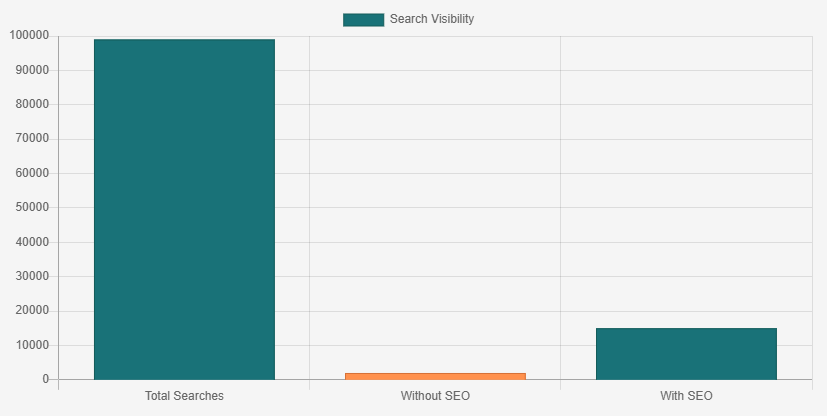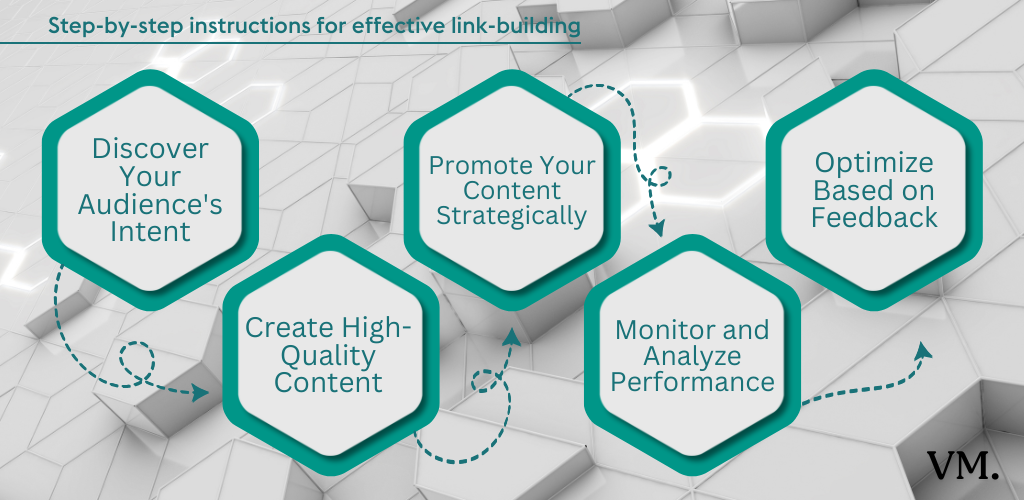Learn link-building strategies. Are you tired of seeing close-to-0 results from your link-building efforts? Do you wish to get high-quality backlinks without resorting to outdated tactics that no longer work? If so, read on to learn how I did it!
Imagine if you could make compelling content that aligns perfectly with what your audience is searching for.
If you understand user intent and integrate it into your link-building strategies, you can create a powerful approach that drives traffic, boosts authority, and earns those coveted backlinks. In this guide, we’ll walk you through actionable steps to build effective link-building strategies that resonate with user intent, ensuring you achieve lasting success in your SEO endeavors.
What is User Intent in Link Building?
User intent refers to the underlying motivation behind a user’s search query. It encompasses what the user hopes to achieve when they enter a specific term into a search engine. Understanding this concept is crucial for developing content that meets the needs of your audience and, consequently, attracts backlinks.
Aligning your content with user intent means creating resources that provide genuine value to users. This approach not only enhances user experience but also increases the likelihood of other websites linking to your content as a valuable resource.

Reasons You Need to Know About User Intent in Link Building
Understanding user intent is essential for several reasons:
- Enhanced Relevance: Content that aligns with user intent is more likely to resonate with your audience, increasing engagement and shares.
- Improved SEO Performance: Search engines prioritize content that satisfies user queries, leading to higher rankings and visibility.
- Quality Backlinks: When your content addresses users’ needs effectively, other websites are more inclined to link back to it as a trusted resource.
- Long-Term Success: Focusing on user intent fosters sustainable growth in traffic and authority over time.
By mastering user intent, you can create a robust link-building strategy that stands out over your competition.
Step-by-Step Instructions to Build Link-Building Strategies Aligned with User Intent
Step 1: Discover Your Audience’s Intent
To discover your audience’s intent, start by brainstorming potential keywords related to your niche. Use keyword research tools to analyze search volume and competition levels for each term. Look for variations in search queries that indicate different types of intent—informational, navigational, or transactional.
For example, if you’re in the fitness industry, users searching for “best workout routines” likely have informational intent, while those looking for “buy running shoes online” exhibit transactional intent. Understanding these nuances will help you tailor your content accordingly.
Step 2: Create High-Quality Content
Once you’ve identified the relevant keywords and their associated intents, it’s time to create high-quality content that meets those needs. Focus on providing comprehensive information that answers users’ questions or solves their problems.
Consider incorporating various formats such as blog posts, infographics, videos, or podcasts to cater to different preferences within your audience. For instance, if you’re targeting users seeking workout routines, consider creating a detailed guide along with video demonstrations for added value.
Step 3: Promote Your Content Strategically
After publishing your content, it’s essential to promote it effectively. Share it across social media platforms where your audience is active and engage with them through comments and discussions. Additionally, consider reaching out directly to influencers or bloggers within your niche who may find value in linking back to your resource.
Craft personalized outreach emails highlighting how your content can benefit their audience while offering them an opportunity for collaboration or guest posting.

Step 4. Monitor and Analyze Performance
Regularly track the performance of your content using analytics tools. Pay attention to engagement metrics and backlink acquisition rates to gauge effectiveness.
Step 5. Optimize Based on Feedback
Use feedback from analytics and audience interactions to refine your content continuously. Adapt your strategies based on what resonates most with your audience.
By following these steps, you can create a comprehensive link-building strategy that aligns seamlessly with user intent.
Key Considerations For Successfully Building Link-Building Strategies Aligned with User Intent
While the steps outlined above provide a solid foundation for developing effective link-building strategies based on user intent, there are key considerations worth noting:
- Stay Updated on Trends: The digital landscape is constantly changing; therefore, staying informed about emerging trends in SEO and user behavior will help you adapt your strategies accordingly.
- Focus on Quality Over Quantity: Aim for high-quality backlinks from authoritative sites rather than pursuing numerous low-quality links. A few relevant links can significantly impact your site’s authority more than many irrelevant ones.
- Engage Your Audience: Foster community engagement by encouraging discussions around your content. This interaction can lead to organic shares and additional backlinks as users find value in what you’ve created.
Taking it to the Next Level: How to Enhance Your Link-Building Strategy
To elevate your link-building strategy beyond basic implementation:
- Leverage Data-Driven Insights: Analyze competitor backlink profiles using SEO tools. Identify opportunities where you can create similar content or reach out for collaborations.
- Utilize Guest Posting: Consider contributing guest posts on reputable sites within your industry. This not only helps build backlinks but also positions you as an authority in your niche.
- Create Shareable Resources: Develop unique resources such as original research studies or comprehensive guides that others would want to reference and share within their networks.
Alternatives to Traditional Link Building
While focusing on user intent is crucial for effective link building, there are alternative methods worth exploring:
- Social Media Engagement: Actively engage with audiences on social media platforms by sharing valuable insights and participating in discussions related to your niche.
- Influencer Collaborations: Partnering with influencers can help amplify your reach and attract quality backlinks through their established networks.
- Content Syndication: Consider syndicating high-quality articles on platforms where they can gain visibility and potentially earn backlinks from interested readers.
Wrapping Up and My Experience With Building Link-Building Strategies Aligned with User Intent
Aligning your link-building strategies with user intent is essential for achieving sustainable success in SEO. By understanding what drives users’ searches and creating valuable content tailored to their needs, you can attract high-quality backlinks that enhance your site’s authority and visibility.
Having implemented these strategies over the years, I’ve witnessed firsthand how focusing on user intent transforms link-building efforts from mere tactics into powerful tools for growth. By following this guide and continuously refining your approach based on feedback and trends, you’ll be well-equipped to thrive in today’s competitive digital landscape.
Now it’s time for you to take action! Start implementing these strategies today and watch as your link-building efforts yield remarkable results!
FAQ
User intent refers to the underlying motivation behind a user's search query. In link building, understanding user intent means creating content that aligns with what users are looking for, whether it’s information, navigation, or transactions. This alignment helps attract relevant backlinks and improves overall SEO performance.
Aligning your link-building strategies with user intent is crucial because it enhances the relevance of your content, improves SEO performance, increases the likelihood of acquiring quality backlinks, and fosters long-term growth in traffic and authority. Content that meets user needs is more likely to be shared and linked to by other websites.
The type of content you create should directly address the identified user intents. For informational intent, consider creating how-to guides, tutorials, or comprehensive articles. For transactional intent, product reviews or comparison articles may be more appropriate. Incorporating various formats such as videos, infographics, and podcasts can also enhance engagement.
To promote your content effectively, share it across social media platforms where your audience is active. Engage with users through comments and discussions to foster community interaction. Additionally, reach out to influencers or bloggers within your niche who may find value in linking back to your resource. Personalized outreach emails can help establish connections and collaborations.
Key considerations for successful link building include staying updated on SEO trends, focusing on quality over quantity when acquiring backlinks, and actively engaging your audience to encourage discussions around your content. Regularly monitoring performance metrics and adapting strategies based on feedback is also essential.
To enhance your link-building strategy, leverage data-driven insights by analyzing competitor backlink profiles and identifying collaboration opportunities. Consider guest posting on reputable sites within your industry to build authority and backlinks. Creating unique resources, such as original research studies or comprehensive guides, can also attract attention and shares.
Alternatives to traditional link-building include engaging with audiences on social media by sharing valuable insights and participating in discussions. Collaborating with influencers can amplify your reach and attract quality backlinks through their networks. Additionally, consider content syndication on platforms where your articles can gain visibility and potentially earn backlinks.
The time it takes to see results from link-building strategies can vary depending on several factors, including the competitiveness of your niche, the quality of your content, and the effectiveness of your promotional efforts. Generally, it may take several weeks to months to observe significant improvements in traffic and backlink acquisition.
Yes! While implementing effective link-building strategies requires time and effort, many aspects can be managed independently if you have a solid understanding of SEO principles and user intent. However, seeking assistance from SEO professionals or agencies may be beneficial if you require more advanced strategies or lack the necessary resources.



